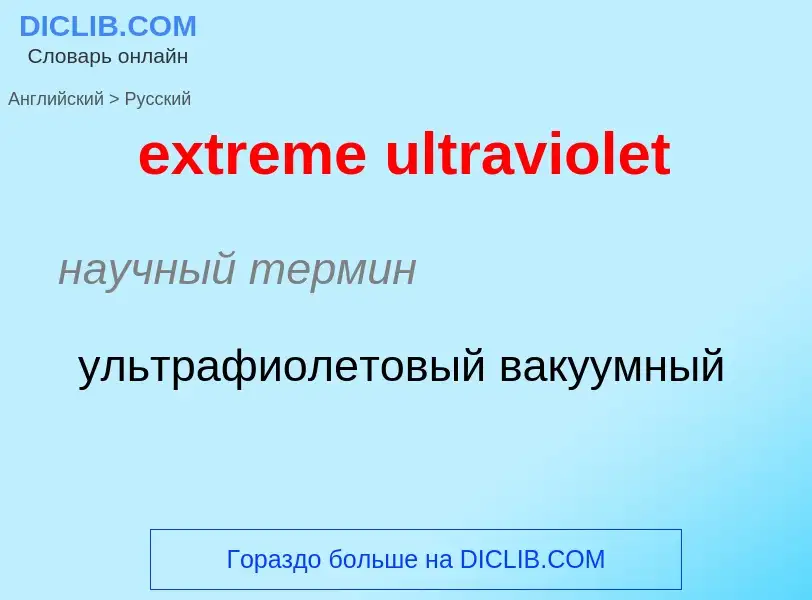Translation and analysis of words by ChatGPT artificial intelligence
On this page you can get a detailed analysis of a word or phrase, produced by the best artificial intelligence technology to date:
- how the word is used
- frequency of use
- it is used more often in oral or written speech
- word translation options
- usage examples (several phrases with translation)
- etymology
extreme ultraviolet - translation to russian
научный термин
ультрафиолетовый вакуумный
['fɑ:(r)ʌltrə'vaiəlit]
существительное
физика
дальняя ультрафиолетовая область (спектра)
дальняя ультрафиолетовая область (спектра)
Definition
Разновидность гармони с клавиатурой фортепьянного типа для правой руки.
Wikipedia

Extreme ultraviolet radiation (EUV or XUV) or high-energy ultraviolet radiation is electromagnetic radiation in the part of the electromagnetic spectrum spanning wavelengths shorter that the hydrogen Lyman-alpha line from 121 nm down to the X-Ray band of 10 nm, and therefore (by the Planck–Einstein equation) having photons with energies from 10.26 eV up to 124.24 eV. EUV is naturally generated by the solar corona and artificially by plasma, high harmonic generation sources and synchrotron light sources. Since UVC extends to 100 nm, there is some overlap in the terms.
The main uses of extreme ultraviolet radiation are photoelectron spectroscopy, solar imaging, and lithography. In air, EUV is the most highly absorbed component of the electromagnetic spectrum, requiring high vacuum for transmission.


![photolithography]] as part of the [[semiconductor fabrication]] process. This image shows an early, experimental tool. photolithography]] as part of the [[semiconductor fabrication]] process. This image shows an early, experimental tool.](https://commons.wikimedia.org/wiki/Special:FilePath/Extreme ultraviolet lithography tool.jpg?width=200)

![UV damaged [[polypropylene]] rope (left) and new rope (right) UV damaged [[polypropylene]] rope (left) and new rope (right)](https://commons.wikimedia.org/wiki/Special:FilePath/Failedrope1.jpg?width=200)

![IR spectrum showing carbonyl absorption due to UV degradation of [[polyethylene]] IR spectrum showing carbonyl absorption due to UV degradation of [[polyethylene]]](https://commons.wikimedia.org/wiki/Special:FilePath/Irspec2.jpg?width=200)
![Aurora at [[Jupiter]]'s north pole as seen in ultraviolet light by the [[Hubble Space Telescope]]. Aurora at [[Jupiter]]'s north pole as seen in ultraviolet light by the [[Hubble Space Telescope]].](https://commons.wikimedia.org/wiki/Special:FilePath/Jupiter.Aurora.HST.UV.jpg?width=200)






![After a training exercise involving fake [[body fluids]], a healthcare worker's [[personal protective equipment]] is checked with ultraviolet light to find invisible drops of fluids. These fluids could contain deadly viruses or other contamination. After a training exercise involving fake [[body fluids]], a healthcare worker's [[personal protective equipment]] is checked with ultraviolet light to find invisible drops of fluids. These fluids could contain deadly viruses or other contamination.](https://commons.wikimedia.org/wiki/Special:FilePath/Ultra-violet screening for potentially Ebola-carrying liquids (15811190376).jpg?width=200)
